E. coli Treatments and Antimicrobial Targets: A Microbiology Overview
VerifiedAdded on 2023/05/30
|5
|770
|88
Homework Assignment
AI Summary
This microbiology assignment provides a comprehensive overview of treatments for diseases caused by E. coli pathogens, including discussions on antimicrobial drug targets and vaccine strategies. It highlights that while there isn't a vaccine available for E. coli infection, rest and hydration are recommended, and antibiotics are generally avoided due to the risk of hemolytic uremic syndrome (HUS). The assignment further explores antibiotic treatments like trimethoprim/sulfamethoxazole or ciprofloxacin and preventative products like Uro-Vaxom. Recent research and developments, such as new biosynthetic pathways for antibiotics, FDA-approved drugs like Aemcolo, and vaccines for cattle, are also discussed, emphasizing ongoing efforts to combat E. coli infections and reduce their spread. The assignment references peer-reviewed articles in APA format.
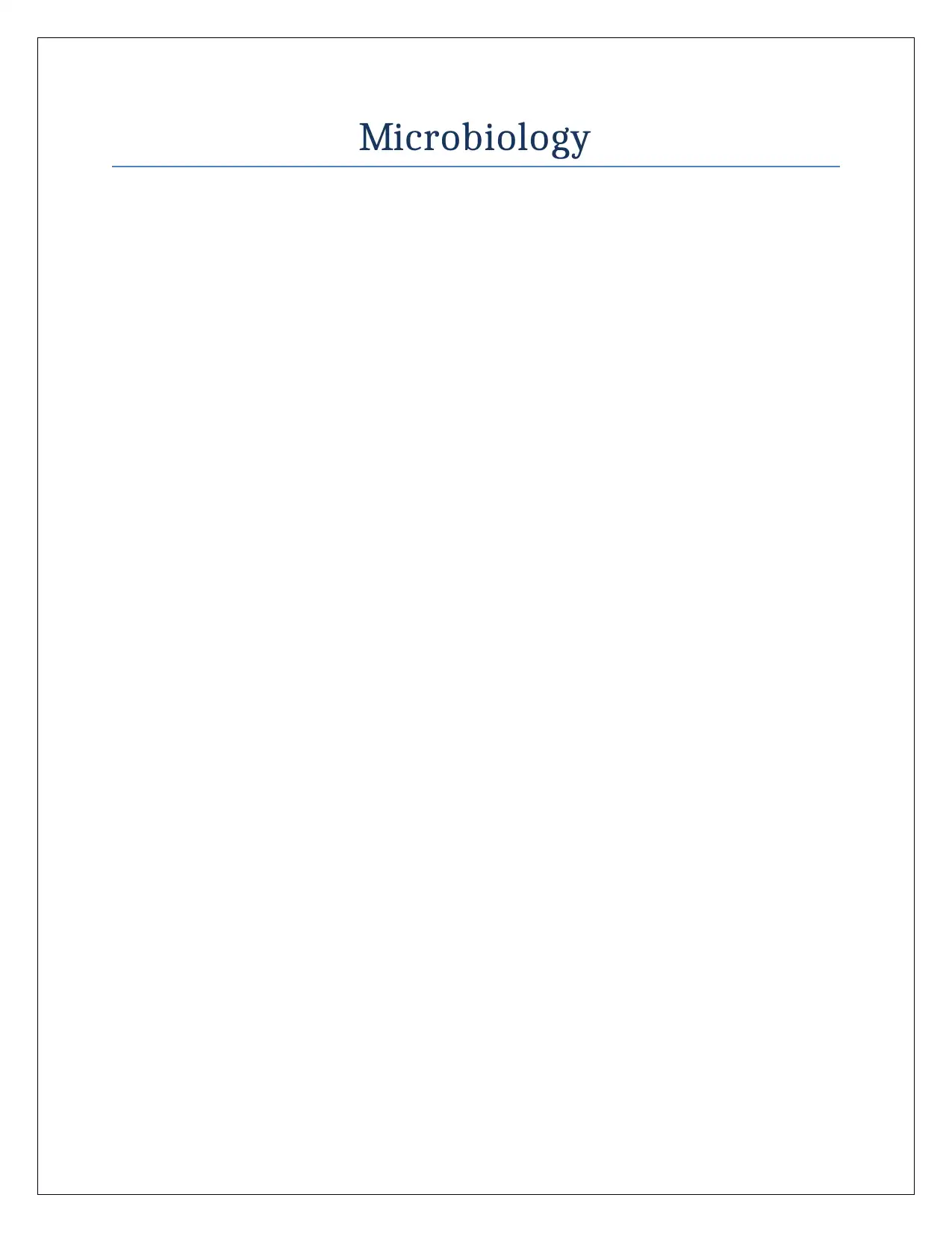
Microbiology
Paraphrase This Document
Need a fresh take? Get an instant paraphrase of this document with our AI Paraphraser
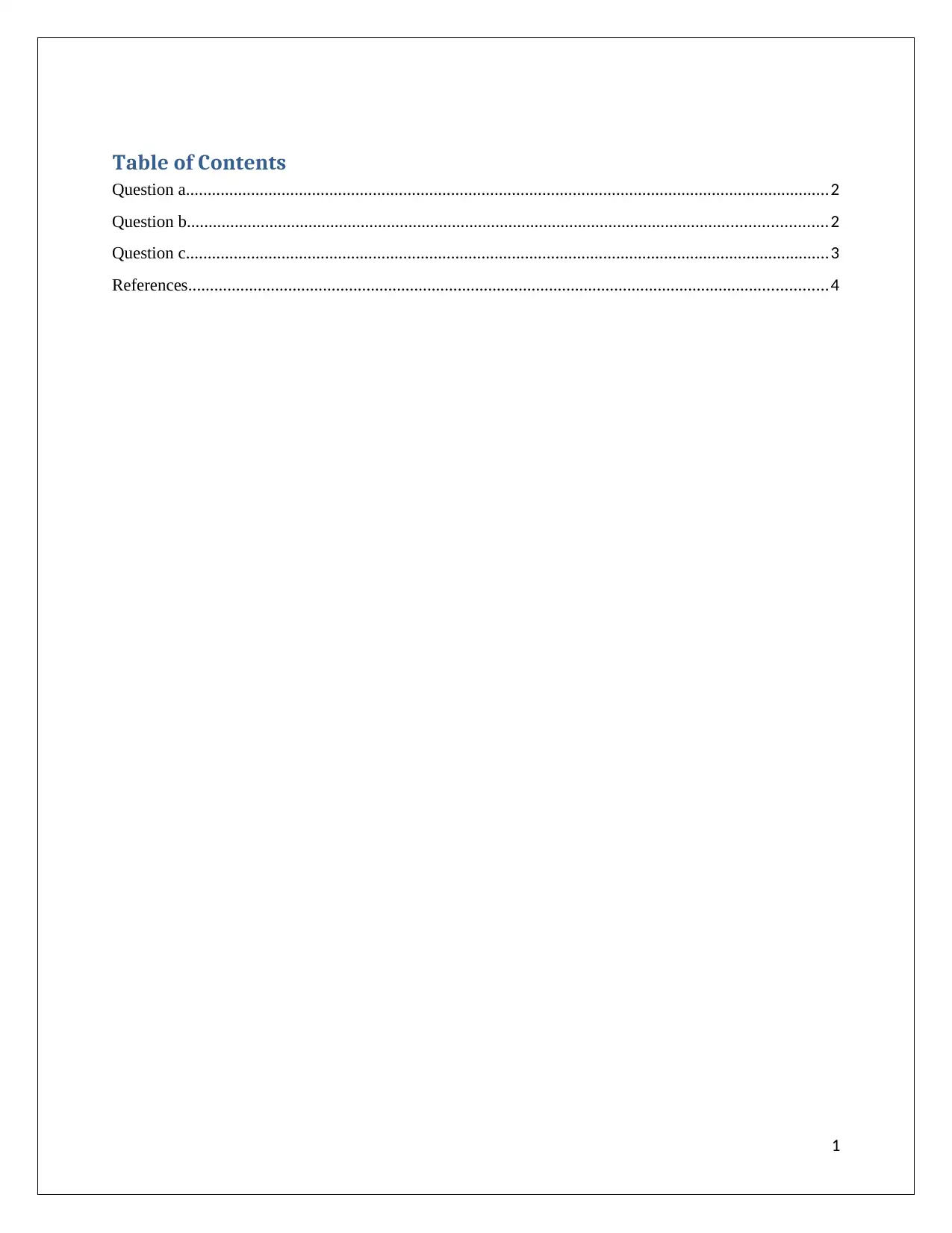
Table of Contents
Question a....................................................................................................................................................2
Question b...................................................................................................................................................2
Question c....................................................................................................................................................3
References...................................................................................................................................................4
1
Question a....................................................................................................................................................2
Question b...................................................................................................................................................2
Question c....................................................................................................................................................3
References...................................................................................................................................................4
1
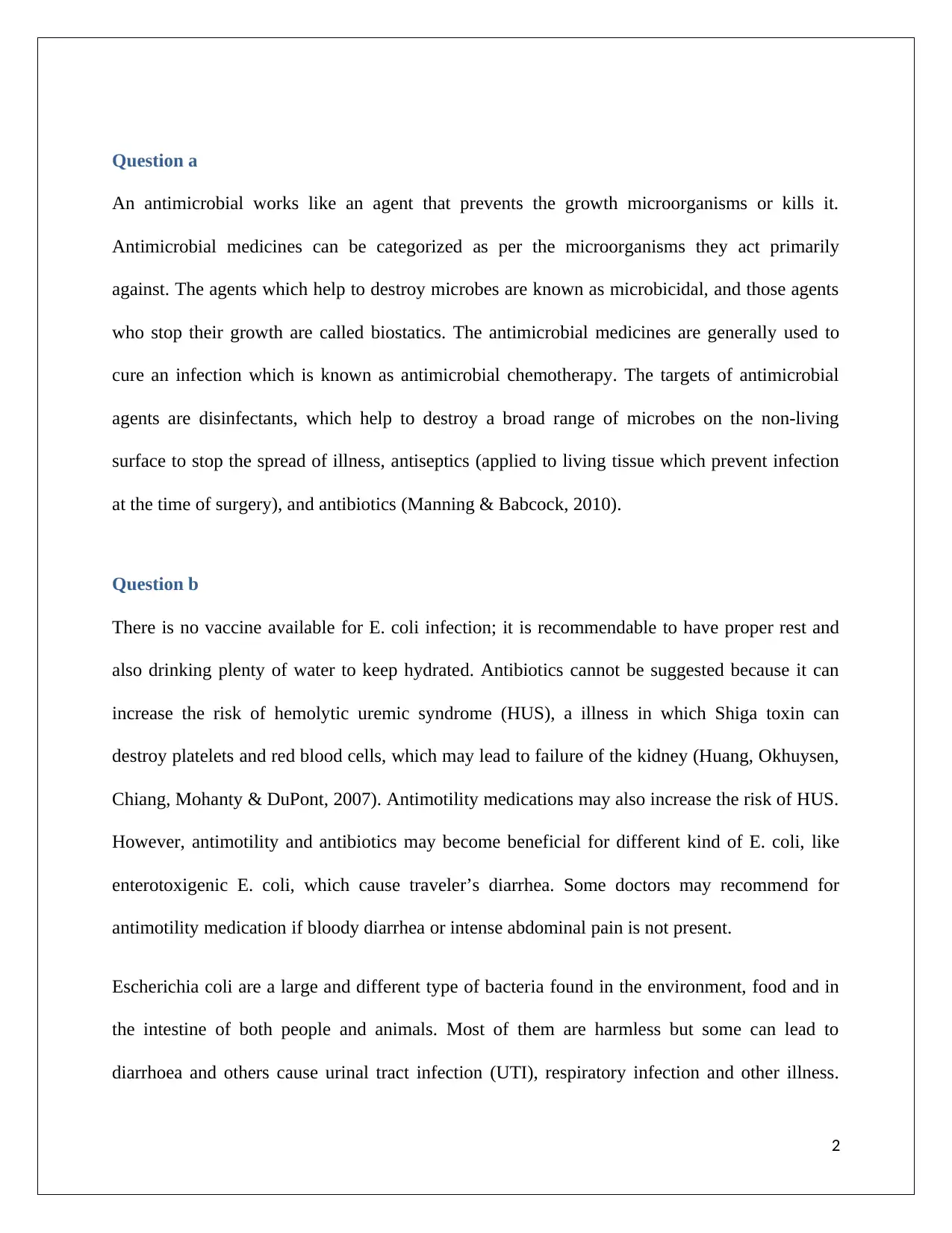
Question a
An antimicrobial works like an agent that prevents the growth microorganisms or kills it.
Antimicrobial medicines can be categorized as per the microorganisms they act primarily
against. The agents which help to destroy microbes are known as microbicidal, and those agents
who stop their growth are called biostatics. The antimicrobial medicines are generally used to
cure an infection which is known as antimicrobial chemotherapy. The targets of antimicrobial
agents are disinfectants, which help to destroy a broad range of microbes on the non-living
surface to stop the spread of illness, antiseptics (applied to living tissue which prevent infection
at the time of surgery), and antibiotics (Manning & Babcock, 2010).
Question b
There is no vaccine available for E. coli infection; it is recommendable to have proper rest and
also drinking plenty of water to keep hydrated. Antibiotics cannot be suggested because it can
increase the risk of hemolytic uremic syndrome (HUS), a illness in which Shiga toxin can
destroy platelets and red blood cells, which may lead to failure of the kidney (Huang, Okhuysen,
Chiang, Mohanty & DuPont, 2007). Antimotility medications may also increase the risk of HUS.
However, antimotility and antibiotics may become beneficial for different kind of E. coli, like
enterotoxigenic E. coli, which cause traveler’s diarrhea. Some doctors may recommend for
antimotility medication if bloody diarrhea or intense abdominal pain is not present.
Escherichia coli are a large and different type of bacteria found in the environment, food and in
the intestine of both people and animals. Most of them are harmless but some can lead to
diarrhoea and others cause urinal tract infection (UTI), respiratory infection and other illness.
2
An antimicrobial works like an agent that prevents the growth microorganisms or kills it.
Antimicrobial medicines can be categorized as per the microorganisms they act primarily
against. The agents which help to destroy microbes are known as microbicidal, and those agents
who stop their growth are called biostatics. The antimicrobial medicines are generally used to
cure an infection which is known as antimicrobial chemotherapy. The targets of antimicrobial
agents are disinfectants, which help to destroy a broad range of microbes on the non-living
surface to stop the spread of illness, antiseptics (applied to living tissue which prevent infection
at the time of surgery), and antibiotics (Manning & Babcock, 2010).
Question b
There is no vaccine available for E. coli infection; it is recommendable to have proper rest and
also drinking plenty of water to keep hydrated. Antibiotics cannot be suggested because it can
increase the risk of hemolytic uremic syndrome (HUS), a illness in which Shiga toxin can
destroy platelets and red blood cells, which may lead to failure of the kidney (Huang, Okhuysen,
Chiang, Mohanty & DuPont, 2007). Antimotility medications may also increase the risk of HUS.
However, antimotility and antibiotics may become beneficial for different kind of E. coli, like
enterotoxigenic E. coli, which cause traveler’s diarrhea. Some doctors may recommend for
antimotility medication if bloody diarrhea or intense abdominal pain is not present.
Escherichia coli are a large and different type of bacteria found in the environment, food and in
the intestine of both people and animals. Most of them are harmless but some can lead to
diarrhoea and others cause urinal tract infection (UTI), respiratory infection and other illness.
2
⊘ This is a preview!⊘
Do you want full access?
Subscribe today to unlock all pages.

Trusted by 1+ million students worldwide
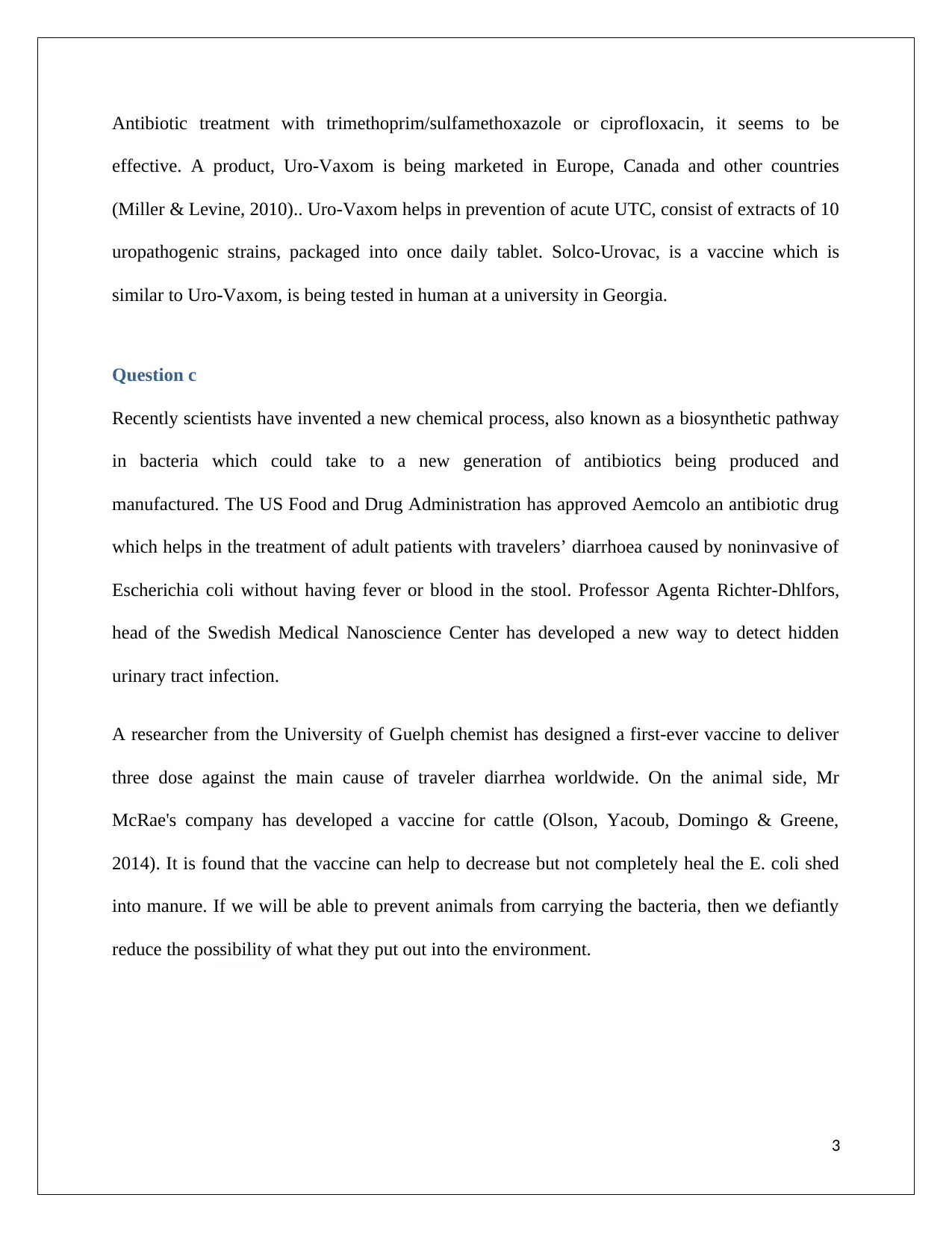
Antibiotic treatment with trimethoprim/sulfamethoxazole or ciprofloxacin, it seems to be
effective. A product, Uro-Vaxom is being marketed in Europe, Canada and other countries
(Miller & Levine, 2010).. Uro-Vaxom helps in prevention of acute UTC, consist of extracts of 10
uropathogenic strains, packaged into once daily tablet. Solco-Urovac, is a vaccine which is
similar to Uro-Vaxom, is being tested in human at a university in Georgia.
Question c
Recently scientists have invented a new chemical process, also known as a biosynthetic pathway
in bacteria which could take to a new generation of antibiotics being produced and
manufactured. The US Food and Drug Administration has approved Aemcolo an antibiotic drug
which helps in the treatment of adult patients with travelers’ diarrhoea caused by noninvasive of
Escherichia coli without having fever or blood in the stool. Professor Agenta Richter-Dhlfors,
head of the Swedish Medical Nanoscience Center has developed a new way to detect hidden
urinary tract infection.
A researcher from the University of Guelph chemist has designed a first-ever vaccine to deliver
three dose against the main cause of traveler diarrhea worldwide. On the animal side, Mr
McRae's company has developed a vaccine for cattle (Olson, Yacoub, Domingo & Greene,
2014). It is found that the vaccine can help to decrease but not completely heal the E. coli shed
into manure. If we will be able to prevent animals from carrying the bacteria, then we defiantly
reduce the possibility of what they put out into the environment.
3
effective. A product, Uro-Vaxom is being marketed in Europe, Canada and other countries
(Miller & Levine, 2010).. Uro-Vaxom helps in prevention of acute UTC, consist of extracts of 10
uropathogenic strains, packaged into once daily tablet. Solco-Urovac, is a vaccine which is
similar to Uro-Vaxom, is being tested in human at a university in Georgia.
Question c
Recently scientists have invented a new chemical process, also known as a biosynthetic pathway
in bacteria which could take to a new generation of antibiotics being produced and
manufactured. The US Food and Drug Administration has approved Aemcolo an antibiotic drug
which helps in the treatment of adult patients with travelers’ diarrhoea caused by noninvasive of
Escherichia coli without having fever or blood in the stool. Professor Agenta Richter-Dhlfors,
head of the Swedish Medical Nanoscience Center has developed a new way to detect hidden
urinary tract infection.
A researcher from the University of Guelph chemist has designed a first-ever vaccine to deliver
three dose against the main cause of traveler diarrhea worldwide. On the animal side, Mr
McRae's company has developed a vaccine for cattle (Olson, Yacoub, Domingo & Greene,
2014). It is found that the vaccine can help to decrease but not completely heal the E. coli shed
into manure. If we will be able to prevent animals from carrying the bacteria, then we defiantly
reduce the possibility of what they put out into the environment.
3
Paraphrase This Document
Need a fresh take? Get an instant paraphrase of this document with our AI Paraphraser
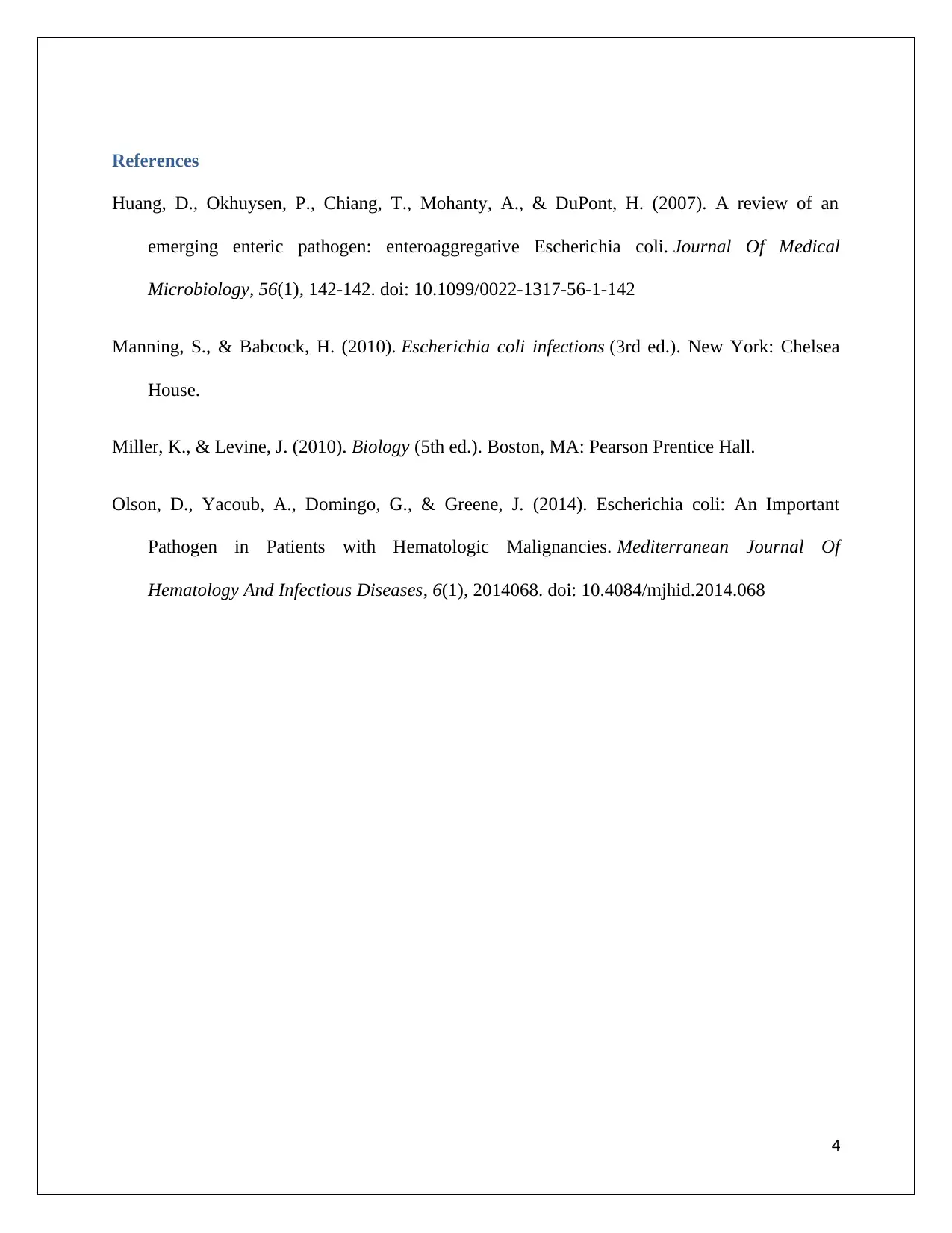
References
Huang, D., Okhuysen, P., Chiang, T., Mohanty, A., & DuPont, H. (2007). A review of an
emerging enteric pathogen: enteroaggregative Escherichia coli. Journal Of Medical
Microbiology, 56(1), 142-142. doi: 10.1099/0022-1317-56-1-142
Manning, S., & Babcock, H. (2010). Escherichia coli infections (3rd ed.). New York: Chelsea
House.
Miller, K., & Levine, J. (2010). Biology (5th ed.). Boston, MA: Pearson Prentice Hall.
Olson, D., Yacoub, A., Domingo, G., & Greene, J. (2014). Escherichia coli: An Important
Pathogen in Patients with Hematologic Malignancies. Mediterranean Journal Of
Hematology And Infectious Diseases, 6(1), 2014068. doi: 10.4084/mjhid.2014.068
4
Huang, D., Okhuysen, P., Chiang, T., Mohanty, A., & DuPont, H. (2007). A review of an
emerging enteric pathogen: enteroaggregative Escherichia coli. Journal Of Medical
Microbiology, 56(1), 142-142. doi: 10.1099/0022-1317-56-1-142
Manning, S., & Babcock, H. (2010). Escherichia coli infections (3rd ed.). New York: Chelsea
House.
Miller, K., & Levine, J. (2010). Biology (5th ed.). Boston, MA: Pearson Prentice Hall.
Olson, D., Yacoub, A., Domingo, G., & Greene, J. (2014). Escherichia coli: An Important
Pathogen in Patients with Hematologic Malignancies. Mediterranean Journal Of
Hematology And Infectious Diseases, 6(1), 2014068. doi: 10.4084/mjhid.2014.068
4
1 out of 5
Related Documents
Your All-in-One AI-Powered Toolkit for Academic Success.
+13062052269
info@desklib.com
Available 24*7 on WhatsApp / Email
![[object Object]](/_next/static/media/star-bottom.7253800d.svg)
Unlock your academic potential
Copyright © 2020–2025 A2Z Services. All Rights Reserved. Developed and managed by ZUCOL.





